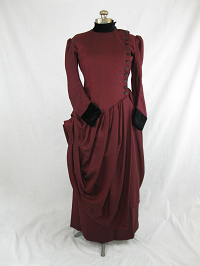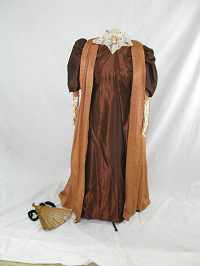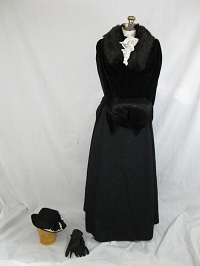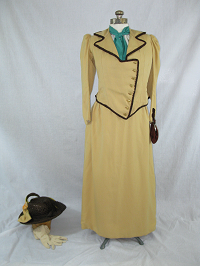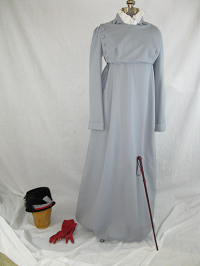
- Details
- Category: 19th century
- Hits: 2581
1890s
This riding outfit or walking dress is of red and black wool with matching velveteen. The long pointed bodice fastens on the left side with jet buttons. The standing collar and cuffs are velveteen. An overskirt of wool is arranged to fall in a leaf-shaped piece on the front of the underskirt, and is put in full at the waist. The sides are long and flowing and the back is puffed over a bustle. The underskirt is mounted on a cotton foundation. Cording or braid is still used along the bottom of the skirt to take the wear. The bodice is completely lined and worked as one piece of material. A black petticoat and bustle are underneath. High black leather shoes are popular. It is now difficult to distinguish between the hat and the bonnet.
Click photo for detailed views.
- Details
- Category: 19th century
- Hits: 2759
1890s
Tea gown. Tea gowns, introduced in the 1870s, grew in popularity to become elaborate showpieces. This gown was copied from a design by Worth of Paris. It is unique in design and materials. It is a long flowing caftan of rust colored cloth draped over a fitted gown with sheath like closeness. The caftan front frames the figure with wide reviers. The fullness is narrowly massed on the shoulders. The full back falls in watteau-like pleats. The gown beneath is fitted by darts and fastens invisibly on the left. The collar is fronted with lace and deep cuffs of lace trim the sleeves. The gown was pictured in Harper's Bazaar, December 1891. Worth was an architect and built his gowns over a corset which forced a woman's body into the shape he wanted.
While petticoat materials and colors started to change in the 1890s, not every woman had the inclination or the means to purchase the colored silks that "dame fashion" dictated. A woman of modest means might wear her winter petticoat of wool rather than silk. This example is an antique. It was considered stable enough to use sparingly in the shows because of the bottom detail. What was worn beneath? A corset and knickers, of course!
Click photo for detailed views.
- Details
- Category: 19th century
- Hits: 2850
1890s
The color of mourning in the 1890s was black. A widow spent two years mourning a husband. During the first year, only black wool trimmed in black crepe was allowed. During the second year, black silk and lace were common. For the last six months of the two-year mourning period, a woman was permitted to wear gray, violet, or white trim on her clothing.
The mourning period lasted for six months for the death of a brother, sister, or child. The death of a friend or acquaintance was mourned for six months, but only if they left you an inheritance.
Men wore a black arm band to indicate mourning, but had no other changes to their everyday clothing.
This graceful winter suit would have been appropriate attire to go out for an evening. The skirt is flat in the front with pleats on each side and pleated in the back. The coat bodice has nine deep points. A bouffant pouf of velvet is set under the middle point in the back and terminates in two long points which fall low on the skirt. The sleeves are cut with a small puff at the top which was stylish in 1890. Although suits with separate blouses became popular at this time, we constructed this one with only a chemisette (or dickey) that fills in the neck and down the front. There are also frills around the sleeve edge. A round hat of black felt trimmed in ostrich plumes and flowers top the upswept hair style. A fur muff and kid gloves complete the outfit. Even her petticoat is black. It's of taffeta and has embroidered spots and a border.
Click on the image for detailed views.
- Details
- Category: 19th century
- Hits: 2627
1888
This is a traveling suit. The bustle of the 1880s has decreased in size as can be seen in this gold-striped wool suit. The tailored gown is a Parisian adaptation of the straight English skirt and a habit-basque (a type of riding jacket). The habit-basque opens on a collar and chemisette of white silk, with a sailor knotted scarf of green silk. Gold buttons fasten the front with a smart and slimming diagonal line. The brown braid trim edges the collar front and bottom edge of the basque emphasizing the pleated fullness in the back to cover the bustle. Hat, gloves, and pocket book complete the outfit. The skirt is plain with hip darts to fit the front and tightly pleated to form all the fullness needed in the back. One type of bustle was made of hair cloth which was gathered and rolled to give the body needed to support the weight of the skirt.
Click photo for detailed views.
- Details
- Category: 19th century
- Hits: 2581
1805
While the method of land transportation continued to be by carriage and horseback, riding costumes were a must for every woman's wardrobe. This is a reproduction of an "Empire" gown which was used for riding between 1800-1810. The coat worn earlier was shortened with the new empire waistline. It still retains most of the features of a man's coat but now falls into the basque (pleats) just below the shoulder blades. It is lined with gray silk.
The front of the coat is closed with self-covered buttons. Seen at the neck is the double ruffle of the lawn habit shirt. Beneath the coat a tiny bodice tops the long skirt. The bustle roll of wadded wool is sewn inside the back of the skirt. The skirt was made long enough to cover the feet while riding. Until on horseback it had to be tied up or carried over the arm. There are tapes and tabs inside the skirt which permit the habit to be worn for traveling. Black shoes, red limerick gloves and a hat trimmed with ribbon and feathers complete the outfit.
Click image for detailed views.
Page 11 of 13
